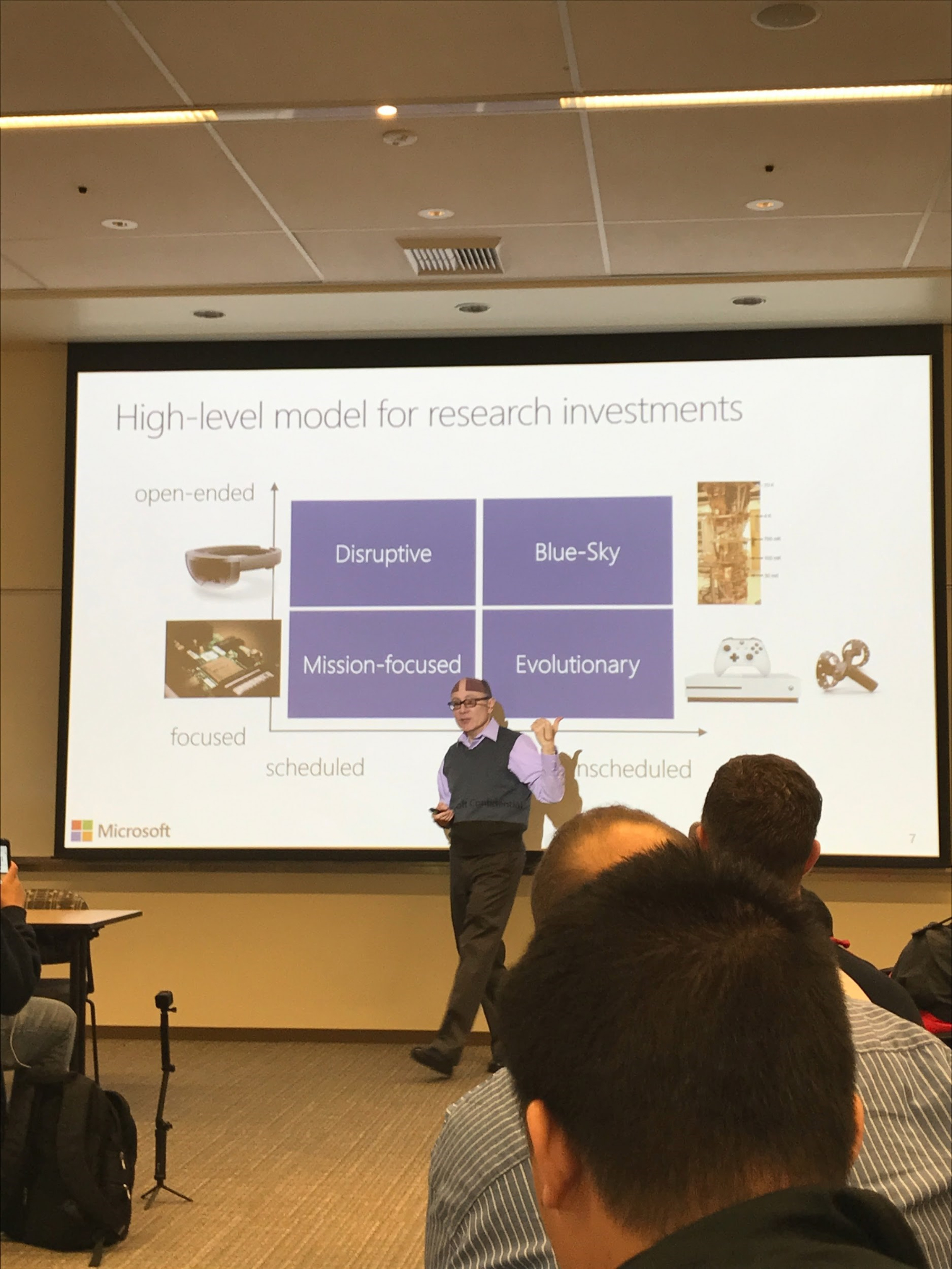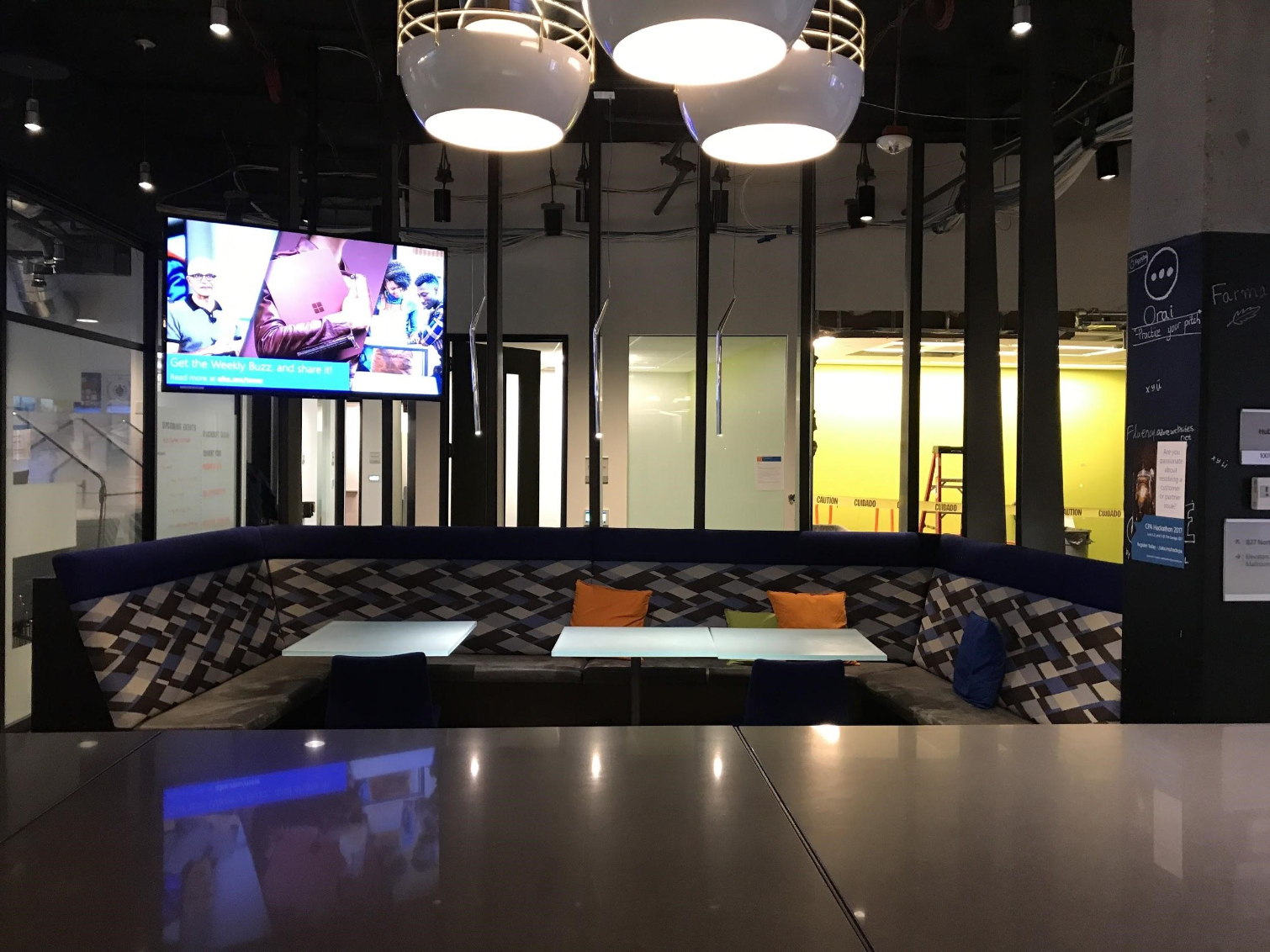Microsoft Campus Tour
In With The Old
Microsoft didn’t have much planned for the last day of its Build developer conference, so it offered members of the media a quick tour of its campus. What can only be described as a gaggle of tired reporters shuffled onto buses outside the Grand Hyatt Seattle, whipped out their phones, and took the trip out to Redmond. Our first stop: The original Microsoft campus, which Bill Gates designed to make sure nobody was interrupted while they were coding. Everyone had an office with a door, and many of those offices had a view of this pond, where brightly colored fish could be seen meandering about.
MORE: History Of Microsoft Windows
MORE: Windows 10 Creators Update, Pictured
Hello, Old Friend
Remember when the Windows logo wasn’t a quadru of flat squares? Somebody must, because this depiction of the old logo can be found right along the main path into Microsoft’s original campus. We couldn’t tell whether this was graffiti or an official mural, but either way, the iconographic throwback reinforced the idea that we were starting our tour with the old Microsoft.
MORE: History Of Microsoft Windows
MORE: Windows 10 Creators Update, Pictured
Giving Back To The Community
The new Microsoft is too big for everyone to have their own office. We’re told that more than 40,000 employees work from the company’s headquarters. A growing number live in Seattle, but many call the towns surrounding their employer home.
Get Tom's Hardware's best news and in-depth reviews, straight to your inbox.
Microsoft has tried to embrace its outsized presence in Redmond (and the other towns in which parts of its campus fall) by encouraging its employees to volunteer in the community. Signs like this one dotted the campus. TEALS has a simple goal--getting computer science classes into every high school. Considering the fact that it’s a tech company, it makes sense for Microsoft to support this mission, both with signs like this and via Microsoft Philanthropies.
MORE: History Of Microsoft Windows
MORE: Windows 10 Creators Update, Pictured
The Shuttles Stop Here
For those employees who live in Seattle, Microsoft offers shuttles between the city and its campus. We were told that these shuttles offer air conditioning, WiFi access, and other amenities to make the (relatively short) commute as painless as possible. Alas, our group was too large to use those shuttles, so we have to take Microsoft’s word for it on their luxuriousness. Other, smaller shuttles ferry employees around different parts of the sprawling headquarters.
MORE: History Of Microsoft Windows
MORE: Windows 10 Creators Update, Pictured
No Badge? No Entry
Once you get to the campus, you’re going to need a badge to get anywhere interesting. Only one building is open to the public; the rest are locked until an employee swipes their badge. Besides keeping out the masses (and curious journalists), the badge system also helps Microsoft keep track of where its employees are. This data is used to predict how many people are working on campus on any given day, how that number is affected by various factors, etc. All that info also helps Microsoft keep tens of thousands of people fed each day. (More on that later.)
MORE: History Of Microsoft Windows
MORE: Windows 10 Creators Update, Pictured
Looking Like The Microsoft Logo Is Totally A Coincidence
After we looked around the original campus and headed over to another building, we sat down for presentations from several Microsoft researchers. First up was Microsoft's Chief Scientist and Distinguished Engineer, Rico Malvar, who told us how the company approaches its research. He said that Microsoft Research often has a push-pull relationship with the company’s product divisions. Sometimes the product teams push for certain research, and sometimes the research team lets the product divisions know about some cool stuff they’re working on. Here you can see him explaining how Microsoft decides where to invest its research. Stuff like HoloLens is scheduled and disruptive; the quantum computer in the top right, however, is blue-sky and non-scheduled. Malvar said it’s important for Microsoft to invest in all four groups--though perhaps not at the same amount--when it’s deciding what to research.
MORE: History Of Microsoft Windows
MORE: Windows 10 Creators Update, Pictured
Water Cooling To The Extreme With Project Natick
Later we heard from Microsoft’s Spencer Fowers about Project Natick. That project was meant to solve a complicated problem: How can Microsoft keep its data centers running as often as possible, while limiting their effect on the environment, and ensuring quick connections to consumers? Fowers said that many U.S. data centers are currently located in the center of the country because that’s where land is cheapest. Yet most people live on the coasts; this means it takes longer for data to travel between consumers and the data centers. Project Natick tries to solve all those problems by submerging a data center in the ocean. The prototype was supposed to last for 35 days, but it ran for 105 before Microsoft pulled it out of the water. Project Natick could lead to a future where data transfers are faster, less money is spent on cooling hot data centers, and Microsoft doesn’t have to swap out parts all the time. (And don’t worry about the fish--Fowers said the first prototype had a negligible effect on surrounding temperatures.)
MORE: History Of Microsoft Windows
MORE: Windows 10 Creators Update, Pictured
Project Premonition Saves Lives With AI And Bug Juice
Finally, on the research side of things, we heard from Microsoft’s Ethan Jackson about Project Premonition, which used a specially designed device and a bunch of AI to analyze mosquito blood. Jackson compared the mosquitoes to little drones capable of collecting DNA samples from animals. This in turn allowed Microsoft to analyze the DNA found within the mosquitoes to figure out what they were feeding on and what diseases they might be carrying. This all happened very quickly--Project Premonition gathered 20GB of data from 22,000 mosquitoes in just 19 hours. Microsoft’s hope is to use all this data to predict disease patterns.
MORE: History Of Microsoft Windows
MORE: Windows 10 Creators Update, Pictured
Shuttle Up And Work
Here’s one of the shuttles we didn’t get to ride. Notice how everything is on-brand; there’s no old Microsoft logo or Helvetica to be found here. It’s all new logotype and Segoe all the time. (Yes, noticing this does make us incredible nerds, and yes, you’re reading this on Tom’s Hardware, so chances are good that you would’ve spotted the same thing. Don’t judge us.)
MORE: History Of Microsoft Windows
MORE: Windows 10 Creators Update, Pictured
Green, Far As The Eye Can See (Until You Turn Around)
Just in case you didn’t believe us, here’s a roundabout for shuttles and other vehicles. Right there on the side is a Real Estate & Facilities truck with the same ol’ Segoe. But we didn’t snap this shot just to make a typographic point. We also wanted to show that Microsoft’s campus is defined by lots of green space. That’s partly due to local regulations, which prohibit buildings taller than four stories, but also because Microsoft wants to blend in with the landscape as much as possible. We suspect all that green is also welcome if you spend most of your day starting at a computer screen.
MORE: History Of Microsoft Windows
MORE: Windows 10 Creators Update, Pictured
Welcome To The Garage, We’ve Got Lots Of Toys
Next up was the Garage. This is where Microsoft employees gather to participate in hackathons, work on personal projects, and in some cases help their kids with schoolwork. The head of the Garage, Jeff Ramos, said Microsoft encourages this free-wheeling creativity. That’s because “culture eats strategy for lunch,” he said, which means it’s more important for Microsoft to create a workplace focused on experimentation than for it to set a new corporate mission. So far the Garage has put out 70 projects, hosted numerous events, and spread to Microsoft offices around the world. You can find out more about this experimental division on its website.

Nathaniel Mott is a freelance news and features writer for Tom's Hardware US, covering breaking news, security, and the silliest aspects of the tech industry.
-
drwho1 I rather see a tour of the Playboy Mansion... a chance to see all their "technology" of course.Reply -
JamesSneed This quote is mostly true but many times the "ugly" produce actually taste better because they were harmed in some way during there development and produced more carbohydrates i.e. sugars to repair. This is especially true of apples and an ugly apple will also have more antioxidants.Reply
"Nobody wants ugly veggies on their shelves even though they taste the same and, in all likelihood, are going to be chopped up anyway." -
urbanj ...they can just use the Lend-O-Matic. Ramos demonstrated the machine’s ease of use by having an iPhone (yes, an iPhone, not a Windows Phone) dispensed right in front of the group of touring journalists.Reply
Well, ya....wouldn't all the employees already HAVE a Windows Phone??
It's the iPhone they'd need to borrow :P
-
alextheblue Reply
Not to mention the shared codebase and emulators they have for mobile mean they can do pretty much all of their UWP development just with a PC and have it run on all UWP platforms with minimal changes (other platforms too if they opt for Xamarin + Forms, depending on the app).19716031 said:...they can just use the Lend-O-Matic. Ramos demonstrated the machine’s ease of use by having an iPhone (yes, an iPhone, not a Windows Phone) dispensed right in front of the group of touring journalists.
Well, ya....wouldn't all the employees already HAVE a Windows Phone??
It's the iPhone they'd need to borrow :P










